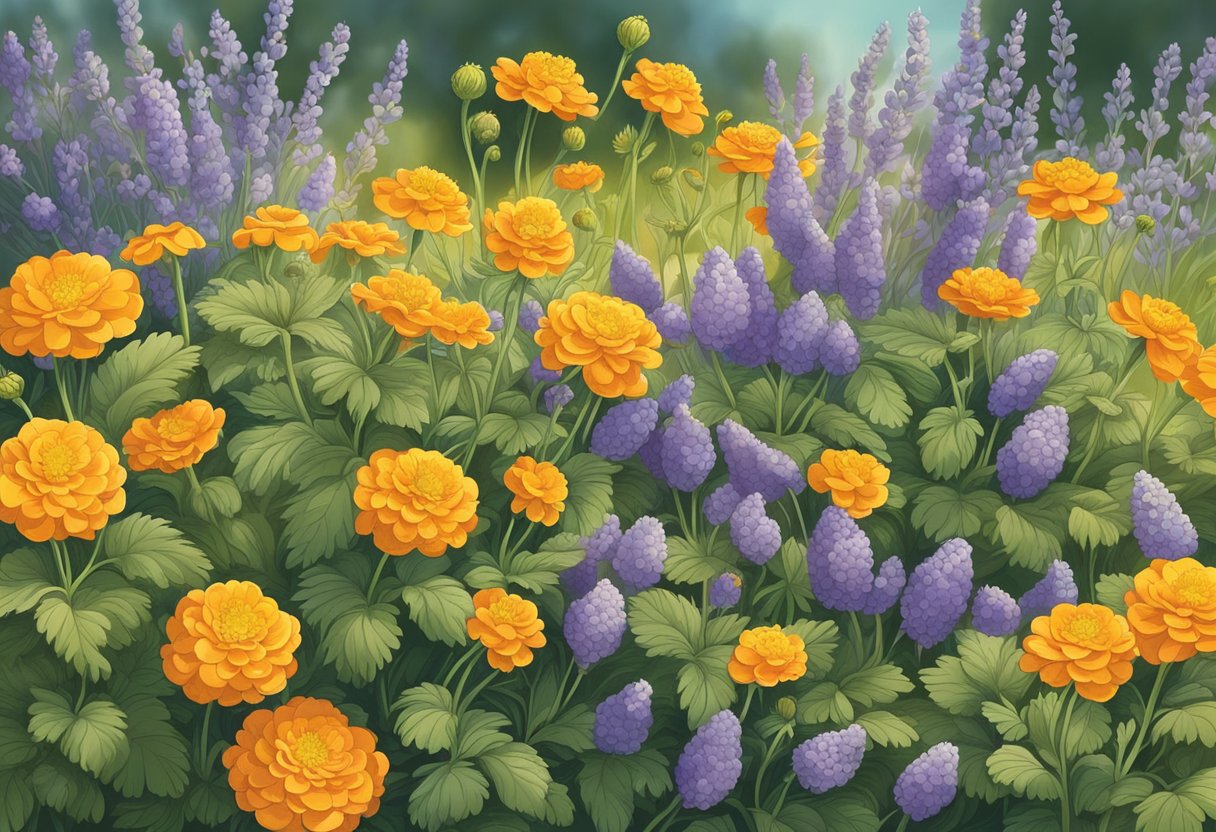As an avid gardener, I find the practice of companion planting very rewarding, especially when it involves strawberries, a popular addition to any vegetable garden. Integrating flowers in the strawberry patch not only maximizes the space but also offers various benefits that can enhance the health and yield of these beloved berries. Engaging with nature’s intricate web, I’ve learned how flowers can attract pollinators, deter pests, and even improve the flavor and vigor of the strawberries.

From my experience, the thoughtful selection of companion flowers is key. It’s fascinating to observe how certain varieties can provide ground cover to maintain soil moisture, some can ward off common strawberry pests, and others bring in beneficial insects. This symbiotic relationship emboldens the notion that a diverse ecosystem within the garden can stave off diseases and balance nutrient uptake, ensuring that my strawberry plants thrive.
I choose flowers such as marigolds and borage for my strawberry plants because they not only beautify the garden but also play a role in natural pest control and pollination.
JUMP TO TOPIC
The Essentials of Companion Planting
When I incorporate companion planting in my garden, I focus on creating robust, healthy ecosystems. Choosing the right companions for my strawberries is paramount to enhancing crop yield, attracting vital pollinators, and maintaining soil health.
Benefits of Companion Planting with Strawberries
Companion planting with strawberries enriches and protects my garden in multiple ways:
When planting strawberries, I carefully select companion plants that attract beneficial insects, repel pests, and act as a living mulch to suppress weeds and conserve moisture. This symbiotic relationship not only improves the strawberries’ health but also enhances their flavor and yields.
-
Attract Beneficial Insects: Flowers like marigolds and borage draw pollinators such as bees and predatory insects, which can help control pests naturally.
-
Repel Pests: The scent of certain companion plants can deter unwanted insects, reducing the need for chemical pesticides.
-
Prevent Disease: Spacing out plants that act as living mulch, such as thyme, can ensure better air circulation around my strawberries, reducing the risk of fungal diseases.
I make it a point to intersperse flowers among my strawberry plants because the diverse ecosystem they create improves the overall health and productivity of my garden.
Strategic Pairings and Layouts in the Garden
Every plant in the garden has companions that can help it thrive. My experience has taught me that strawberries pair well with certain flowers and herbs that serve different purposes, from pest control to maximizing yield.
Companion Plants for Strawberries
To enhance the strawberry garden, strategic planting of flowers and herbs is key.
💥 Flowers and Herbs
- Borage: Known for attracting pollinators and deterring pests.
- Thyme: Excellent ground cover that can help deter worms.
- Marigolds: Their scent can repel harmful nematodes and other pests.
- Garlic and Chives: Repel aphids, which are common strawberry pests.
Edible companions like spinach act as a living mulch, keeping the soil moist and weed competition low. Asparagus can be planted with strawberries as well; it uses different parts of the soil profile and its tall fronds can provide shade later in the season.
What Not to Plant with Strawberries
Certain plants can hinder strawberry growth and should be avoided.
| Plant | Reason to Avoid |
|---|---|
| Tomatoes | Can transmit blight to strawberries. |
| Potatoes | May share common pests and diseases. |
| Beans | Their growth can be too competitive with strawberries. |
By avoiding the planting of tomatoes, potatoes, and beans near strawberries, I work to prevent any potential for disease or competition for resources that could adversely affect the health and yield of my strawberry plants.
Optimizing Your Strawberry Garden
In optimizing a strawberry garden, careful consideration is required for pest management and natural control solutions to promote healthy growth while minimizing damage.
Managing Pests and Diseases
I’ve discovered that strawberry plants are susceptible to various pests such as aphids, spider mites, and slugs, as well as diseases like fungal pathogens. Deer and rabbits also pose a threat by feeding on the plants. An effective strategy is to incorporate plants that repel pests or attract beneficial insects, thereby creating a balanced ecosystem. For instance, chives can deter aphids and spider mites due to their strong aroma.
Deer/Rabbits: Use fencing to protect plants.
Slugs/Aphids: Introduce plants that attract predators like ladybugs.
Fungal Diseases: Promote good air circulation and use resistant plant varieties.
Natural Pest Control Solutions
I ensure that natural methods are in place to control potential infestations. Planting trap crops around the strawberries can lure pests away, while aromatic plants may keep them at bay.
Natural pest control can be achieved by planting borage, which attracts pollinators and repels unwanted pests with its accumulation of beneficial minerals.
Ladybugs: These friendly insects feed on aphids and thrips, acting as natural pest controllers.
Fungal Diseases: Always water at the base to prevent water on the leaves, reducing the risk of fungal diseases.
By integrating these practices into my garden, I create a self-sustaining environment where strawberries can thrive with minimal interference. The key is to work with nature, not against it.












